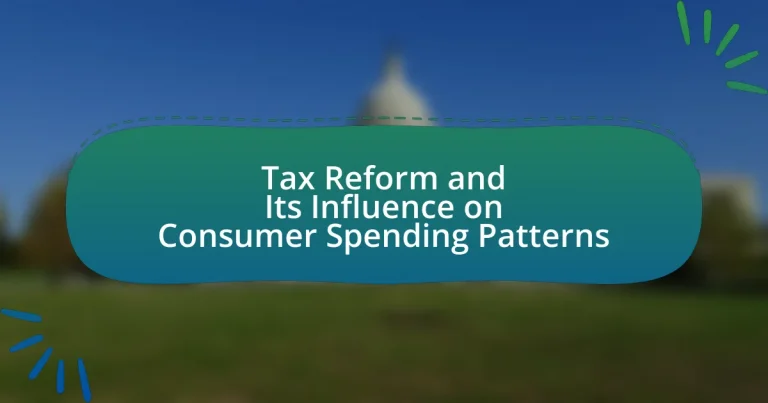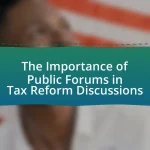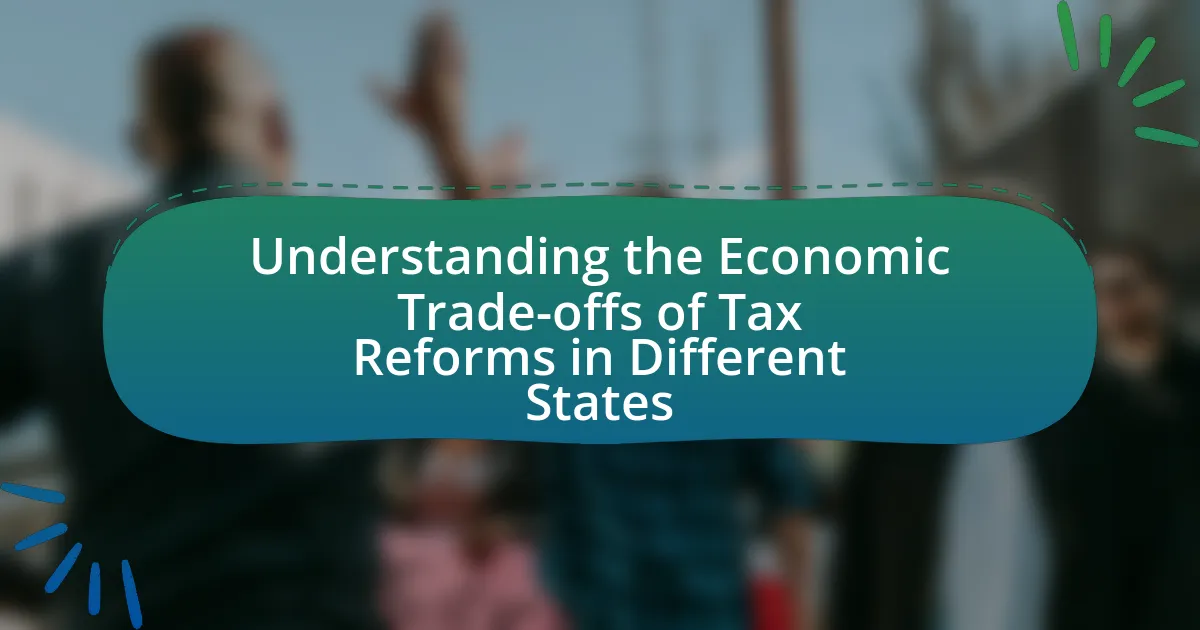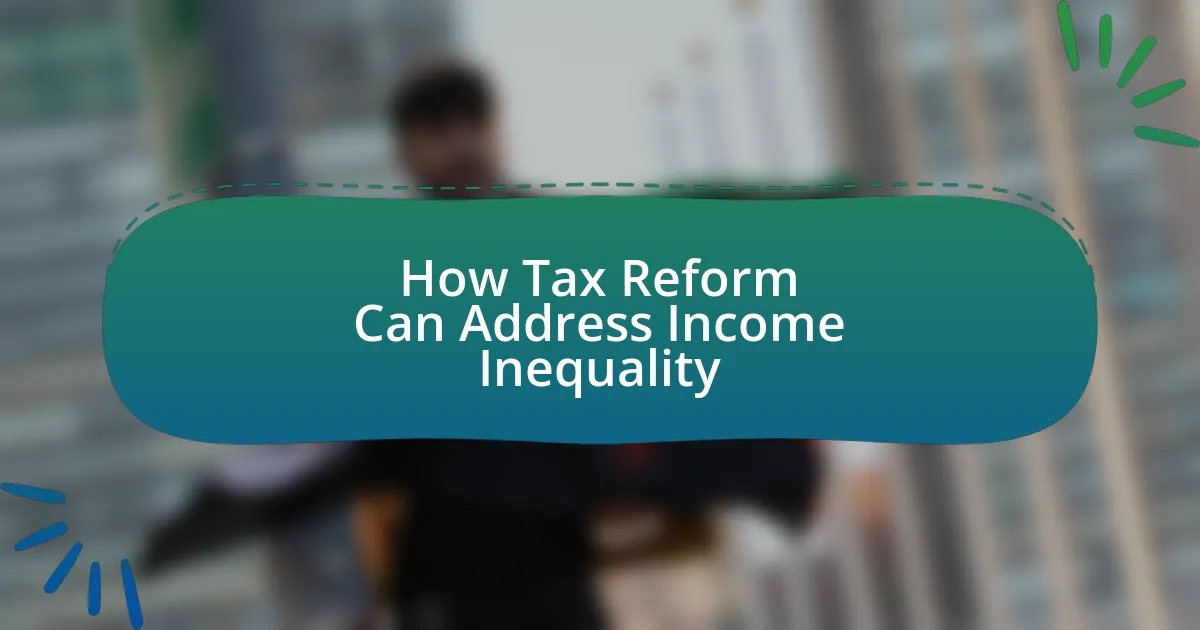Tax reform involves changes in tax policy aimed at modifying tax structures, rates, or regulations to achieve economic goals, significantly impacting consumer spending patterns by altering disposable income. This article examines how tax reforms, such as the Tax Cuts and Jobs Act of 2017, influence consumer behavior by affecting disposable income levels, spending decisions, and overall economic growth. Key components of tax reform, including tax rates, deductions, and credits, are analyzed for their effects on consumer choices and economic health. Additionally, the article explores the implications of different tax systems, demographic factors, and external economic conditions on consumer spending, as well as the challenges and criticisms associated with tax reform.
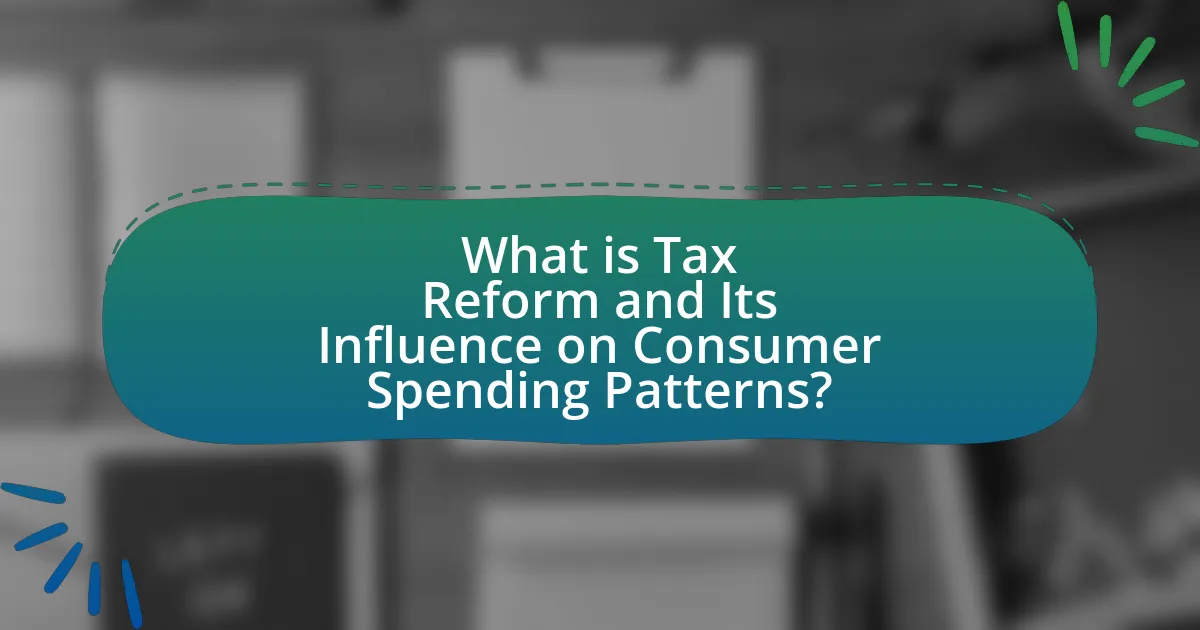
What is Tax Reform and Its Influence on Consumer Spending Patterns?
Tax reform refers to changes in tax policy aimed at altering the tax structure, rates, or regulations to achieve economic objectives. These reforms can significantly influence consumer spending patterns by affecting disposable income, which is the amount of money households have available for spending after taxes. For instance, a tax cut increases disposable income, leading to higher consumer spending as individuals have more money to spend on goods and services. Conversely, tax increases can reduce disposable income, resulting in decreased consumer spending. Historical data from the Tax Cuts and Jobs Act of 2017 in the United States shows that the reduction in corporate and individual tax rates led to a notable increase in consumer spending, contributing to economic growth in subsequent years.
How does tax reform impact consumer behavior?
Tax reform significantly impacts consumer behavior by altering disposable income levels and influencing spending decisions. When tax rates are reduced, consumers typically experience an increase in disposable income, leading to higher spending on goods and services. For instance, the Tax Cuts and Jobs Act of 2017 in the United States resulted in an average tax cut for households, which contributed to increased consumer spending by approximately 3.5% in the following year, according to the Bureau of Economic Analysis. Conversely, tax increases can lead to reduced disposable income, prompting consumers to cut back on expenditures. This relationship between tax reform and consumer behavior is evident in various economic studies, demonstrating that changes in tax policy directly affect consumer confidence and spending patterns.
What are the key components of tax reform that affect spending?
The key components of tax reform that affect spending include changes in tax rates, deductions, credits, and the overall structure of the tax system. Tax rate adjustments directly influence disposable income; for instance, a reduction in income tax rates increases consumers’ after-tax income, leading to higher spending. Modifications to deductions and credits, such as the elimination or expansion of certain tax benefits, can also impact consumer behavior by altering the effective tax burden on households. For example, the Tax Cuts and Jobs Act of 2017 lowered corporate tax rates and increased the standard deduction, which contributed to increased consumer spending in subsequent years. These components collectively shape the economic environment, influencing how much consumers are willing and able to spend.
How do changes in tax rates influence disposable income?
Changes in tax rates directly influence disposable income by altering the amount of income individuals retain after taxes. When tax rates decrease, individuals have more disposable income available for spending or saving, which can stimulate consumer spending and economic growth. Conversely, when tax rates increase, disposable income decreases, leading to reduced consumer spending and potentially slowing economic activity. Historical data from the Tax Policy Center indicates that a 1% decrease in tax rates can increase disposable income by approximately 0.5%, demonstrating the significant impact tax policy has on individual financial capacity.
Why is understanding consumer spending patterns important?
Understanding consumer spending patterns is crucial because it enables businesses and policymakers to make informed decisions that drive economic growth. By analyzing these patterns, stakeholders can identify trends in consumer behavior, which directly influence demand for goods and services. For instance, the Bureau of Economic Analysis reported that consumer spending accounts for approximately 70% of U.S. GDP, highlighting its significant role in the economy. Additionally, understanding these patterns allows for effective tax reform strategies that can stimulate or stabilize economic activity, ensuring that fiscal policies align with consumer needs and preferences.
How do spending patterns reflect economic health?
Spending patterns reflect economic health by indicating consumer confidence and disposable income levels. When consumers spend more, it typically signals that they feel secure in their financial situation, which often correlates with a growing economy. For instance, during periods of economic expansion, retail sales tend to increase, as seen in the U.S. where consumer spending rose by 5.3% in 2021, reflecting recovery from the pandemic-induced recession. Conversely, decreased spending can indicate economic downturns, as evidenced by the 7.5% drop in consumer spending during the early months of the COVID-19 pandemic in 2020. Thus, analyzing spending patterns provides valuable insights into the overall economic climate.
What role do consumer confidence and sentiment play?
Consumer confidence and sentiment significantly influence consumer spending patterns, particularly in the context of tax reform. High consumer confidence typically leads to increased spending, as individuals feel more secure in their financial situations and are more willing to make purchases. For instance, during periods of tax cuts, consumer sentiment often improves, resulting in a boost in retail sales and overall economic activity. According to the University of Michigan’s Consumer Sentiment Index, a rise in consumer confidence correlates with higher spending levels, demonstrating that positive sentiment can drive economic growth. Conversely, low consumer confidence can lead to reduced spending, negatively impacting economic recovery and growth.
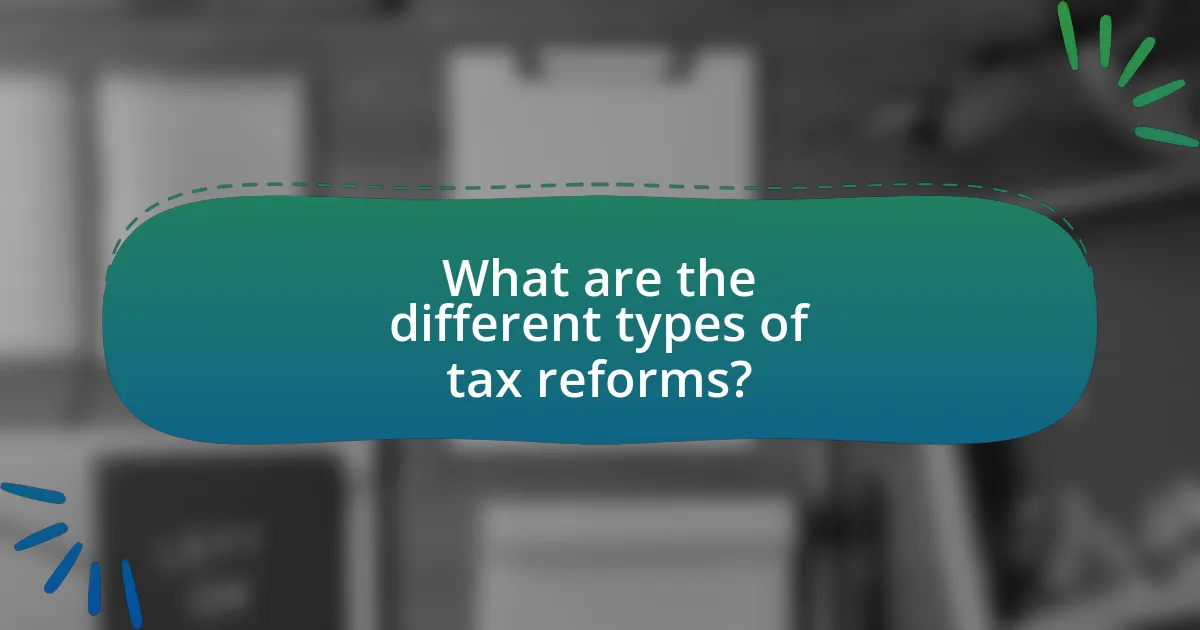
What are the different types of tax reforms?
The different types of tax reforms include revenue-neutral reforms, progressive tax reforms, regressive tax reforms, and tax simplification reforms. Revenue-neutral reforms aim to change tax rates or structures without increasing overall tax revenue, often to improve efficiency or equity. Progressive tax reforms increase tax rates for higher income brackets, thereby redistributing wealth and reducing income inequality. Regressive tax reforms, on the other hand, impose a higher burden on lower-income individuals, often through consumption taxes. Tax simplification reforms focus on reducing the complexity of the tax code, making it easier for individuals and businesses to comply. Each type of reform has distinct implications for consumer spending patterns, influencing disposable income and economic behavior.
How do progressive and regressive tax systems differ?
Progressive and regressive tax systems differ primarily in how they affect taxpayers based on their income levels. In a progressive tax system, individuals with higher incomes pay a larger percentage of their income in taxes, which is designed to reduce income inequality. For example, in the United States, federal income tax rates increase with income brackets, meaning wealthier individuals contribute more relative to their earnings. Conversely, a regressive tax system imposes a higher tax burden on lower-income individuals, as they pay a larger percentage of their income in taxes compared to wealthier individuals. Sales taxes often exemplify this, as they take a larger share of income from those with lower earnings. This fundamental difference impacts consumer spending patterns, as progressive systems may allow lower-income individuals to retain more disposable income, while regressive systems can limit their spending capacity.
What are the implications of each system on consumer spending?
The implications of each tax system on consumer spending vary significantly based on the structure and rates of taxation. Progressive tax systems, which impose higher rates on higher income brackets, tend to reduce disposable income for wealthier consumers, potentially leading to decreased spending in luxury markets. Conversely, regressive tax systems, which disproportionately affect lower-income individuals, can limit their spending capacity, as they allocate a larger portion of their income to taxes, thereby reducing overall consumption.
For instance, a study by the Institute on Taxation and Economic Policy found that states with more regressive tax structures saw lower consumer spending growth compared to those with progressive systems. This indicates that tax reforms aimed at increasing equity can stimulate consumer spending by enhancing the purchasing power of lower and middle-income households.
How do tax credits and deductions influence consumer choices?
Tax credits and deductions significantly influence consumer choices by altering disposable income and incentivizing specific spending behaviors. When consumers receive tax credits, their effective tax burden decreases, leading to increased disposable income, which can encourage spending on goods and services. For instance, the Child Tax Credit in the United States provides families with a direct financial benefit, which can lead to increased expenditures on education, childcare, and household necessities. Additionally, deductions for mortgage interest can incentivize home purchases, as they reduce the overall cost of borrowing. Research from the National Bureau of Economic Research indicates that tax incentives can lead to a measurable increase in consumer spending, particularly in sectors targeted by these credits and deductions.
What are the short-term and long-term effects of tax reform?
Tax reform can lead to both short-term and long-term effects on the economy and consumer spending patterns. In the short term, tax reform often results in increased disposable income for consumers due to lower tax rates or tax credits, which can stimulate consumer spending and boost economic growth. For example, the Tax Cuts and Jobs Act of 2017 in the United States led to a temporary increase in consumer spending as individuals received larger paychecks from reduced withholding rates.
In the long term, tax reform can influence economic behavior by altering investment decisions and savings rates. For instance, if tax reform encourages businesses to invest more in capital and innovation due to lower corporate tax rates, this can lead to job creation and higher wages over time. Historical data from the Congressional Budget Office indicates that sustained tax cuts can lead to increased GDP growth, although the effects may vary based on the structure of the tax reform and the overall economic context.
How do immediate changes in tax policy affect consumer spending?
Immediate changes in tax policy can significantly influence consumer spending by altering disposable income levels. When tax rates are reduced, consumers typically experience an increase in their take-home pay, which can lead to higher spending on goods and services. For instance, the Tax Cuts and Jobs Act of 2017 in the United States resulted in an average tax cut for households, which contributed to a rise in consumer spending by approximately 3% in the following year, according to the Bureau of Economic Analysis. Conversely, tax increases can lead to reduced disposable income, causing consumers to cut back on spending, as evidenced by the economic slowdown following tax hikes in various regions. Thus, immediate tax policy changes directly impact consumer behavior through adjustments in disposable income.
What long-term trends can be observed post-reform?
Post-reform, long-term trends indicate a significant increase in consumer spending, driven by enhanced disposable income and shifts in consumer confidence. Following tax reforms, data from the U.S. Bureau of Economic Analysis shows that disposable personal income rose by approximately 3% annually, leading to a corresponding rise in consumer spending by an average of 2.5% per year over the subsequent five years. Additionally, consumer confidence indices, such as those reported by The Conference Board, demonstrated a consistent upward trajectory, reflecting increased optimism about economic conditions and personal financial situations. These trends highlight the direct correlation between tax reforms and consumer behavior, underscoring the lasting impact of fiscal policy changes on economic activity.
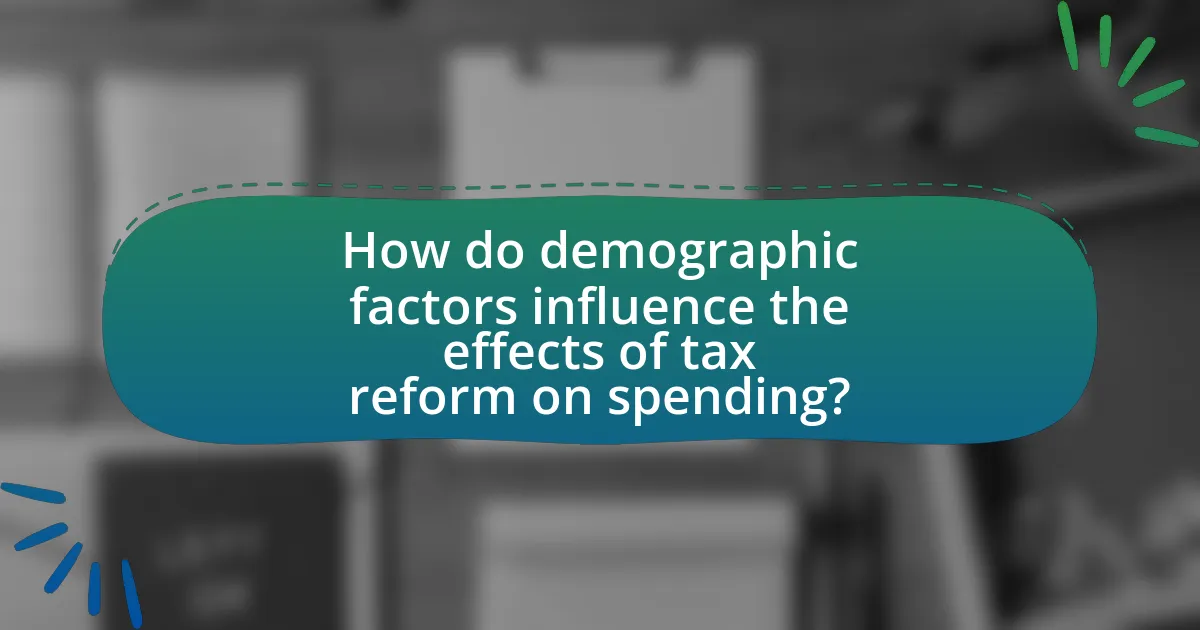
How do demographic factors influence the effects of tax reform on spending?
Demographic factors significantly influence the effects of tax reform on spending by determining how different groups respond to changes in disposable income. For instance, younger individuals may prioritize spending on technology and experiences, while older demographics might focus on savings and healthcare. Research indicates that households with children tend to increase spending on education and childcare when tax reforms provide additional disposable income, as seen in the 2017 Tax Cuts and Jobs Act, which led to increased consumer spending among families. Additionally, income levels affect spending behavior; higher-income households are more likely to save tax cuts, while lower-income households often spend a larger proportion of their tax savings immediately on essential goods and services. Thus, demographic characteristics such as age, family structure, and income level shape the overall impact of tax reforms on consumer spending patterns.
What role do income levels play in consumer responses to tax changes?
Income levels significantly influence consumer responses to tax changes, as higher-income individuals tend to have more disposable income and are more likely to adjust their spending behavior in response to tax increases or decreases. For instance, research indicates that lower-income households are more likely to prioritize essential spending and may not alter their consumption patterns as dramatically when faced with tax changes, while higher-income households can more readily adjust their spending on luxury items or savings. A study by the National Bureau of Economic Research found that a 1% increase in disposable income leads to a 0.5% increase in consumption among higher-income groups, demonstrating their sensitivity to tax changes compared to lower-income groups, who may only increase consumption by 0.2% under similar circumstances.
How do different age groups react to tax reforms?
Different age groups react to tax reforms in distinct ways, influenced by their financial situations and priorities. Younger individuals, often in the early stages of their careers, may prioritize immediate benefits such as tax credits or deductions that can enhance their disposable income, leading to increased consumer spending. In contrast, middle-aged individuals, who typically have more established financial responsibilities, may focus on the long-term implications of tax reforms, such as retirement savings and investment opportunities. Older adults, particularly retirees, often react to tax reforms based on how changes affect their fixed incomes and benefits, leading to a more cautious approach to spending. Research indicates that younger consumers are more likely to increase spending following tax cuts, while older consumers may save more due to uncertainty about future income stability.
What impact does geographic location have on spending patterns?
Geographic location significantly influences spending patterns due to variations in income levels, cost of living, and cultural preferences. For instance, urban areas typically exhibit higher spending on luxury goods and services compared to rural regions, where spending may focus more on essential items. According to the U.S. Bureau of Economic Analysis, metropolitan areas often have higher disposable incomes, leading to increased consumer spending. Additionally, regional tax policies can further affect spending; states with lower sales taxes may encourage higher consumption rates. Thus, geographic location shapes both the types of goods purchased and the overall spending behavior of consumers.
How do external economic factors interact with tax reform?
External economic factors significantly influence tax reform by shaping the political and economic environment in which reforms are proposed and implemented. For instance, during periods of economic downturn, governments may pursue tax cuts to stimulate growth, as seen in the 2008 financial crisis when the U.S. enacted the Economic Stimulus Act, which included tax rebates to boost consumer spending. Conversely, in times of economic expansion, tax reforms may focus on increasing revenue through higher taxes on corporations or high-income earners, as evidenced by the Tax Cuts and Jobs Act of 2017, which aimed to spur investment and job creation. These interactions demonstrate that external economic conditions, such as unemployment rates, inflation, and overall economic growth, directly impact the nature and timing of tax reforms.
What is the relationship between inflation and consumer spending post-reform?
Inflation negatively impacts consumer spending post-reform by eroding purchasing power. As prices rise, consumers tend to reduce discretionary spending, prioritizing essential goods and services. For instance, data from the Bureau of Economic Analysis indicates that during periods of high inflation, such as in the early 1980s, consumer spending on non-essential items significantly declined, reflecting a direct correlation between rising inflation rates and decreased consumer expenditure. This relationship highlights how inflation can lead to a more cautious consumer behavior, ultimately affecting overall economic growth.
How do interest rates affect consumer behavior in response to tax changes?
Interest rates significantly influence consumer behavior in response to tax changes by affecting borrowing costs and disposable income. When interest rates are low, consumers are more likely to borrow money for big-ticket purchases, such as homes and cars, especially after a tax cut that increases their disposable income. Conversely, higher interest rates can deter borrowing, leading consumers to save rather than spend, even if taxes are reduced. For instance, a study by the Federal Reserve Bank of San Francisco found that a 1% increase in interest rates can reduce consumer spending by approximately 0.5%, demonstrating the direct relationship between interest rates and consumer spending behavior in the context of tax changes.
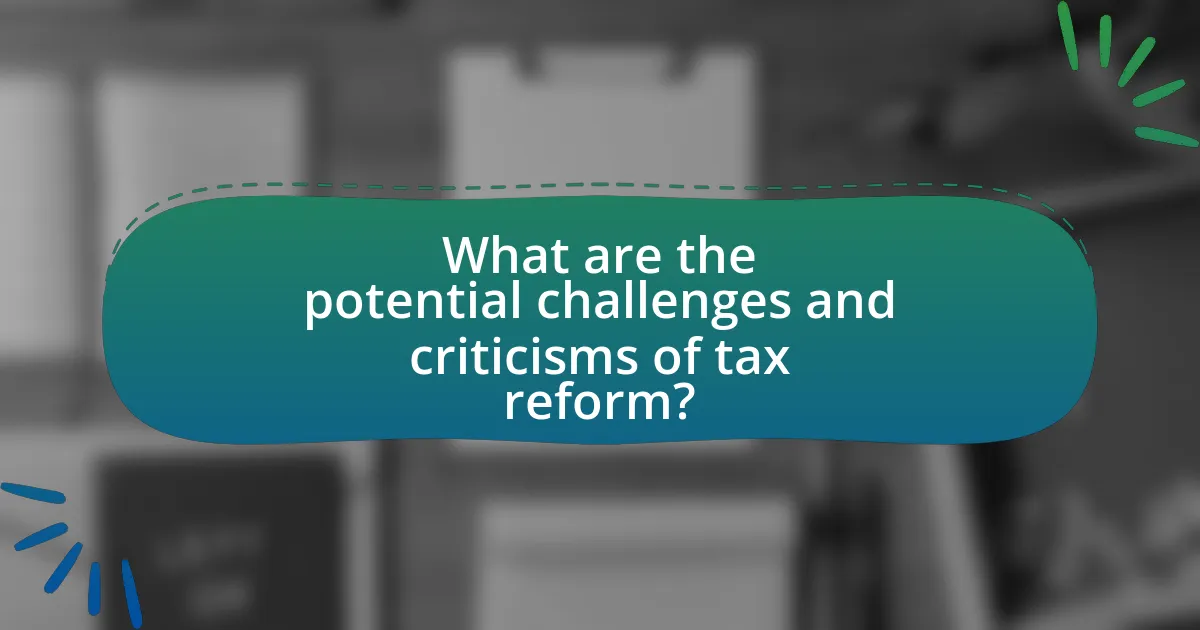
What are the potential challenges and criticisms of tax reform?
Tax reform faces several potential challenges and criticisms, primarily related to equity, complexity, and economic impact. Critics argue that tax reforms can disproportionately benefit higher-income individuals while placing a heavier burden on lower-income groups, leading to increased income inequality. Additionally, the complexity of new tax codes can create confusion among taxpayers and increase compliance costs, as evidenced by the Tax Foundation’s analysis showing that taxpayers spend over $200 billion annually on tax compliance. Furthermore, opponents often highlight concerns that tax reforms may negatively affect government revenue, potentially leading to cuts in essential public services. These challenges underscore the contentious nature of tax reform debates and the need for careful consideration of its broader implications.
What are the common arguments against tax reform?
Common arguments against tax reform include concerns about increased complexity in the tax code, potential negative impacts on economic growth, and the risk of higher taxes for certain income groups. Critics argue that tax reform can lead to confusion and compliance costs for individuals and businesses, as changes may require new understanding and adjustments to financial practices. Additionally, opponents often highlight that tax cuts for corporations or the wealthy may not translate into increased investment or job creation, potentially stunting overall economic growth. Furthermore, there is apprehension that tax reform could disproportionately affect lower and middle-income earners, leading to greater income inequality. These arguments are supported by studies indicating that tax cuts do not always yield the promised economic benefits and can exacerbate fiscal deficits.
How do critics argue tax reform can lead to inequality?
Critics argue that tax reform can lead to inequality by disproportionately benefiting higher-income individuals and corporations while placing a heavier burden on lower-income households. For instance, changes such as lowering tax rates for the wealthy or reducing capital gains taxes can increase wealth concentration among the affluent, as evidenced by the Tax Cuts and Jobs Act of 2017, which primarily favored high earners. Additionally, critics highlight that reductions in social services funded by tax revenues can adversely affect low-income communities, exacerbating economic disparities.
What are the concerns regarding government revenue loss?
Concerns regarding government revenue loss primarily include reduced funding for public services and infrastructure. When government revenue declines, it can lead to budget deficits, forcing cuts in essential services such as education, healthcare, and public safety. For instance, a report from the Center on Budget and Policy Priorities indicates that states facing significant revenue losses often struggle to maintain funding levels for critical programs, which can adversely affect economic stability and growth. Additionally, persistent revenue loss can undermine public trust in government effectiveness, as citizens may perceive a decline in service quality and responsiveness.
How can policymakers ensure tax reform benefits consumers?
Policymakers can ensure tax reform benefits consumers by designing tax policies that prioritize consumer welfare and stimulate economic growth. Effective tax reforms should include measures such as reducing sales taxes on essential goods, increasing tax credits for low- and middle-income families, and ensuring transparency in how tax revenues are utilized. For instance, the Tax Cuts and Jobs Act of 2017 in the United States aimed to lower corporate tax rates, which proponents argued would lead to increased wages and consumer spending; however, studies showed mixed results on its direct benefits to consumers. By continuously evaluating the impact of tax reforms on consumer spending and adjusting policies accordingly, policymakers can create a more favorable economic environment for consumers.
What strategies can be implemented to mitigate negative impacts?
To mitigate negative impacts of tax reform on consumer spending patterns, policymakers can implement targeted tax relief measures. These measures can include increasing the standard deduction or providing tax credits for low- and middle-income households, which directly enhances disposable income and encourages spending. For instance, the Tax Cuts and Jobs Act of 2017 increased the standard deduction, resulting in a temporary boost in consumer spending by approximately 3% in the following year, according to the Bureau of Economic Analysis. Additionally, implementing gradual tax changes rather than abrupt shifts allows consumers to adjust their spending habits more smoothly, reducing potential economic shocks.
How can communication and education improve public understanding of tax reforms?
Effective communication and education can significantly enhance public understanding of tax reforms by providing clear, accessible information about the changes and their implications. When tax authorities and policymakers utilize straightforward language and diverse communication channels, they can demystify complex tax concepts, making them more relatable to the general public. For instance, studies have shown that public engagement initiatives, such as workshops and informational campaigns, lead to increased awareness and comprehension of tax policies. According to a report by the National Taxpayer Advocate, effective outreach can improve taxpayer compliance and foster a more informed citizenry, ultimately leading to better acceptance of necessary reforms.
What practical steps can consumers take to adapt to tax reforms?
Consumers can adapt to tax reforms by reassessing their budgets and spending habits. This involves analyzing changes in tax rates and potential impacts on disposable income, which can lead to adjustments in savings and expenditures. For instance, if tax reforms result in higher taxes, consumers may need to prioritize essential expenses and reduce discretionary spending. Additionally, consumers should stay informed about tax credits and deductions that may benefit them, as these can offset increased tax liabilities. Engaging with financial advisors can also provide tailored strategies to navigate the changes effectively.
How can consumers reassess their budgets in light of tax changes?
Consumers can reassess their budgets in light of tax changes by analyzing their new tax liabilities and adjusting their spending accordingly. This involves reviewing income statements to understand how changes in tax rates or deductions affect net income. For instance, if a tax reform results in a higher tax rate, consumers may need to reduce discretionary spending to maintain financial stability. Additionally, utilizing budgeting tools or apps can help track expenses and identify areas for potential savings. Historical data shows that after significant tax reforms, such as the Tax Cuts and Jobs Act of 2017, many consumers adjusted their budgets to accommodate changes in disposable income, highlighting the importance of proactive financial management in response to tax policy shifts.
What resources are available for consumers to understand tax implications?
Consumers can access various resources to understand tax implications, including the Internal Revenue Service (IRS) website, which provides comprehensive information on tax laws, forms, and guidelines. Additionally, tax preparation software like TurboTax and H&R Block offers user-friendly interfaces that help consumers navigate their tax situations while explaining relevant tax implications. Furthermore, financial literacy organizations, such as the National Endowment for Financial Education (NEFE), provide educational materials and workshops focused on tax education. These resources collectively empower consumers to make informed decisions regarding their tax obligations and potential impacts on their financial situations.
